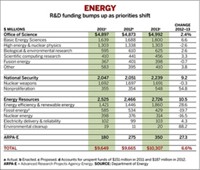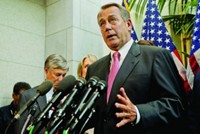Advertisement
Grab your lab coat. Let's get started
Welcome!
Welcome!
Create an account below to get 6 C&EN articles per month, receive newsletters and more - all free.
It seems this is your first time logging in online. Please enter the following information to continue.
As an ACS member you automatically get access to this site. All we need is few more details to create your reading experience.
Not you? Sign in with a different account.
Not you? Sign in with a different account.
ERROR 1
ERROR 1
ERROR 2
ERROR 2
ERROR 2
ERROR 2
ERROR 2
Password and Confirm password must match.
If you have an ACS member number, please enter it here so we can link this account to your membership. (optional)
ERROR 2
ACS values your privacy. By submitting your information, you are gaining access to C&EN and subscribing to our weekly newsletter. We use the information you provide to make your reading experience better, and we will never sell your data to third party members.
Environment
Congress Boosts DOE Science Funds
Office of Science, other R&D programs fare well as agency's 2008 appropriation moves through Congress
by Jeff Johnson
August 6, 2007
| A version of this story appeared in
Volume 85, Issue 32

So far in the congressional appropriation process, next year's funding looks bright for many Department of Energy scientists.
Appearing particularly rosy is the Office of Science appropriation in both the House-passed bill (H.R. 2641) and the Senate's version (S. 1751), which has passed committee but not the full Senate. It is unclear when the Senate bill will make its way to the floor.
Although the bills are favorable to scientists now, the road ahead is pitted with potholes. Still to come is a House-Senate conference to rectify differences between bills passed by the two bodies. Muddying the future further is President George W. Bush's promised veto if the final bill exceeds his original requested appropriation by more than $1 billion, which both bills do.
In a statement of Administration policy concerning the House-passed bill, the White House said the level of spending was "irresponsible and excessive." It also objected to several specific House bill provisions. The House Energy & Water Appropriation funds several agencies besides DOE, but the lion's share (some $25 billion) of the $31.6 billion appropriation goes to DOE, with a budget that would be $480 million beyond Bush's request.
Looking at the Office of Science, H.R. 2641 would provide $4.5 billion, $117 million more than Bush sought for next year and $717 million more than the office received last year. The Senate committee-passed bill provides a few million dollars less, but both show an increase of nearly 20% above this year's funding.
In a House Appropriations Committee report explaining the spending, members underscored crises in energy needs and global warming. "This bill," the report says, "attempts to face these twin crises with over $3 billion to address global climate change-researching its effects and working on technologies to slow it down-and investment in renewable energy programs that both reduce greenhouse gases and help our nation meet its energy needs."
The report singles out a $20 million jump to $150 million for climate-change research directed by the Office of Science to model and monitor the atmosphere and carbon dioxide levels in ecosystems. Most of this additional money will fund the office's Biological & Environmental Research program. Another $208 million, $30 million above the President's request, is directed to research on energy storage and generation technologies, according to the report. Some $70 million of the increase is slated for science laboratory infrastructure improvements at DOE labs, taking total construction infrastructure spending to $128 million.
The appropriation level in the Senate's bill for the Office of Science is similar. But exact comparisons are difficult because the two bills account for funds for congressionally directed projects, or "earmarks," differently. Earmarks are provided in appropriation bills for specific institutions and programs selected by a member of Congress, they are outside DOE control.
The House cleared most of the DOE appropriation bill in late June but put off debate on member-supported earmarks until mid-July. That bill was passed last month and carried some $1.1 billion in earmarks and about $248 million for energy-related projects. In all, some 269 institutions would receive government funds through energy earmarks. Most individual amounts were $1 million or less, but some were as much as $6 million. Most of the funds were provided for energy efficiency and renewable energy areas or were science or technology related.
In the Senate, earmarks are sprinkled throughout the bill. The Biological & Environmental Research program, which usually receives the majority of Office of Science earmarks, would receive about $50 million in Senate earmarks.
Looking at general energy-related funding, the President's original budget request proposed a funding cut for solar, biomass, wind, and vehicle technologies and projects. The House and Senate appropriations, however, do the opposite.
Solar energy spending in the House bill would increase to $200 million, $51 million above the Administration's request and last year's funding. Biofuels R&D would go to $250 million, $70 million above Bush's proposed budget. Funding for vehicle technology and energy efficiency would also be increased. The Senate bill provides similar increased funding for renewable energy.
Nuclear energy research would also get a boost to $759 million, far more than the spending for renewables. Although this level is $51 million less than Bush sought, it is $277 million more than 2007 levels. The House bill, however, would cut the Administration's request for the Global Nuclear Energy Partnership (GNEP), a DOE program to restart nuclear fuel reprocessing in the U.S. The Administration sought $405 million for GNEP, and the House cut it to $120 million. In explaining the reductions, the committee report notes weak nuclear industry support for GNEP, a host of concerns voiced by nuclear scientists, tens of billions of dollars in projected long-term costs, and the availability of short-term waste storage sites that could serve as an alternative to reprocessing (C&EN, June 18, page 48).
The Senate is seeking to spend $720 million on nuclear energy. Like the House, it cut the Administration's GNEP request but with a lighter hand. The Senate would trim the GNEP appropriation to $243 million, twice the House level. In its report, the Senate Appropriations Committee notes that senators were split in their support for the Administration's new program for reprocessing spent fuel. The Senate report directs the Administration to restrict R&D work to existing facilities and urges the Administration to broaden its nuclear research agenda to consider a wider array of potential reprocessing technologies.
Even Sen. Pete V. Domenici (R-N.M.), ranking minority member on the Senate Appropriations Committee with DOE oversight and a longtime supporter of nuclear power and reprocessing, is pushing for a go-slow approach on reprocessing. He noted that "new congressional leadership" wants a "more modest program that can more fully demonstrate the technical and commercial feasibility of closing the nuclear fuel cycle" before moving ahead with a full-fledged reprocessing facility, which DOE is proposing.
Concerning coal, the House bill would provide $709 million, $142 million more than Bush proposed, to develop technologies to capture and sequester carbon from coal-fired power plants. Such an increase in funding was similar to recommendations of a recent Massachusetts Institute of Technology study, the House report notes (C&EN, April 2, page 48).
The Senate's legislation calls for similar increases for developing coal technologies.
Despite similarities in several energy areas, the House and Senate split over funding for nuclear weapons, another big chunk of the DOE budget.
The House bill cuts the President's request for the nuclear weapons program by $632 million to $5.9 billion. Among high-profile areas, the bill eliminates $88 million in funding for a new nuclear weapon, the reliable replacement warhead (RRW). The House bill withholds RRW funding until the Administration develops a nuclear defense strategy in light of the changes that have taken place since the end of the Cold War. House members on the Appropriations Committee have been highly critical of RRW and a DOE plan to overhaul the nuclear weapons complex, the so-called Complex 2030 proposal.
"It is critical that the Administration lay out a comprehensive course of action before funding is appropriated." said Rep. Peter J. Visclosky (D-Ind.), chairman of the House Appropriations subcommittee with DOE oversight. "Given the track record of mismanagement at the agency for projects that have a plan, I don't think it is asking too much for a comprehensive nuclear strategy before we build a new nuclear weapon."
Despite division among Senate members on support for RRW and for modernizing the weapons complex, the legislation provides $66 million of the $88 million the Administration sought for RRW. But it limits spending to fund only RRW research. It, too, urged DOE to develop an overall strategy for weapons and particularly to consider the impact on international nuclear weapons proliferation by the addition of a new U.S. weapon. The appropriation would halt work on DOE's planned new weapons complex until an RRW feasibility study is complete and a decision made whether to move further.
The Senate Appropriations Committee also endorsed creation of a bipartisan congressionally appointed commission to evaluate the role of nuclear weapons in the future before moving ahead with RRW or overhauling the weapons complex. A similar recommendation has been made by the House Armed Services Committee and passed in the National Defense Authorization Act for fiscal 2008, which was approved by the House on May 17.
The Bush Administration is not pleased with these restrictions. Along with opposing the overall funding level in the bills, the Administration specifically objected to the earmarks, to increases in funds set aside for carbon capture and sequestration technologies, to GNEP reductions, and to the elimination of RRW funds.
In a policy document released on July 24, the Departments of Energy, Defense, and State voiced strong opposition to congressional restrictions on RRW. In a four-page document, representatives from the departments stated their intention to develop a detailed report on nuclear strategy, and they threatened that without the new RRW, the U.S. may have to return to nuclear testing to certify the condition of existing weapons.
Senate leadership hopes to pass legislation to fund DOE for 2008 before leaving for the August recess. Many members of Congress have predicted tough conference committee meetings to resolve thorny differences between House and Senate bills. Bush's veto threat will complicate negotiations. Although the House cleared its bill by a veto-proof 312–112 vote on July 17, it is unclear if that margin of support will stand after a bill is modified in House-Senate negotiations.





Join the conversation
Contact the reporter
Submit a Letter to the Editor for publication
Engage with us on Twitter